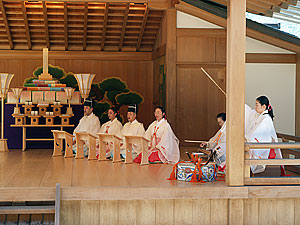Photo Album
Portraits of three branches: Shoko, Tanegashima and Aomori
By Bill Roberts
During a three month stay at Oomoto in the spring of 2008, I visited three branches with Hiromi Yano, deputy chief of the International Department. Here are a few notes and a photographic report.
The Shoko branch, in the Nagoya area, is the only branch not defined by location. More than 40 years ago, an Oomoto follower with great healing powers had to move from her Kobe home to the Nagoya area. Matsuko Matsumoto had attracted quite a following from Kobe and elsewhere, and these Oomoto followers wanted to continue to be associated with her. So they asked the Third Spiritual Leader about it, and she declared that wherever Matsumoto was, that was where the new branch would be. And the Third Spiritual Leader gave it the name, Shoko, meaning pine fragrance.
All other branches are defined by their location, their members from that area. Although Matsumoto died many years ago, the Shoko branch continues to thrive. It has members from as far away as Kobe, Kyoto and Yokohama, a long journey for monthly services, prompting most members to make a weekend of it.
Tanegashima is one of the smaller branches, located on the island of the same name. Tanegashima is very small -- 12 by 57 kilometers — and is located south of the southern tip of Kyushu. It has lush soil and a semi-tropical climate, which permits the healthy growth of nearly every flower and vegetable known to the Japanese. It is the home of Japan’s space center, which launches rockets carrying satellites for commercial and other peaceful purposes.
The population is 30,000 and declining. The branch and the island suffer from the same problem—too few jobs, forcing young people to leave for the larger islands. Except surfers: the island is one of the country’s most popular surfing venues, and some young Japanese move there, take any job they can find, and surf.
Finally, Aomori is located in the city and prefecture of that name at the northern tip of Honshu. Aomori has a great deal of snow in the winter, and a more temperate summer climate than much of Japan. It has beautiful mountains, lakes and rivers, and is a big farming area, especially known for apples.
The Aomori branch is another small one, but as with Tanegashima, and indeed all branches, the followers are dedicated to the principles and rituals of Oomoto.
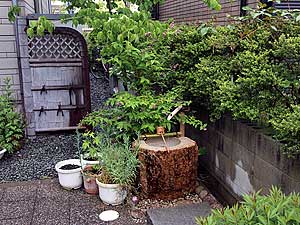
The tsukubai, or water bowl, at the Shoko branch.
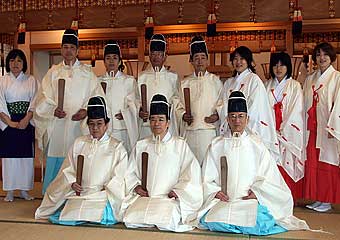
The Shoko branch has a tradition of photographing the priests before each monthly service.
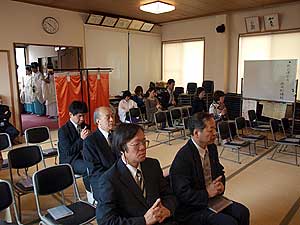
Another tradition at Shoko, members practice chingkon, an ancient form of meditation taught by Co-Founder Onisaburo Deguchi, for a few minutes to calm their minds before the service starts.
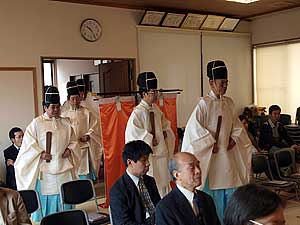
The Shoko monthly service begins.
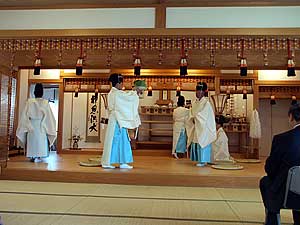
Kensen – offering of fruits and vegetables to the altar.
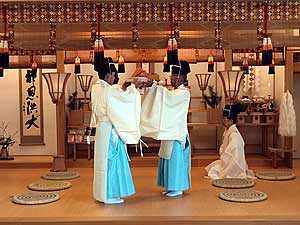
Since they do not live near each other, the priests travel to the branch the day before the service to practice the ritual.
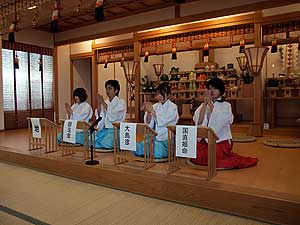
Shoko has a solid youth division (ages 15 to 30). Four times a year they do a reading at the monthly service.
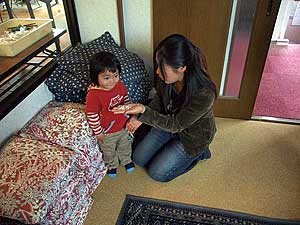
Young people are the future at Oomoto. Smaller branches are having trouble keeping young people.
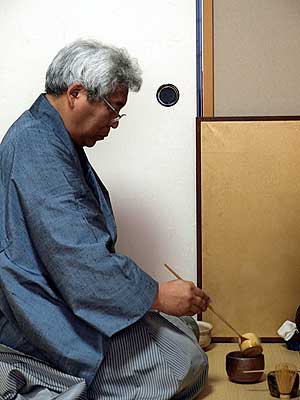
The tea master at Shoko comes all the way from Kameoka each month, a more than two hour trip by train.

Tea ceremony at the Shoko branch.
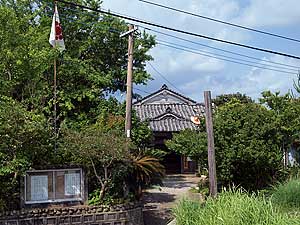
The Tanegashima branch has a beautiful garden.
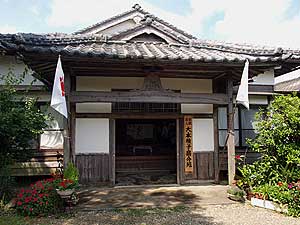
The traditional architecture at Tanegashima is special, too.
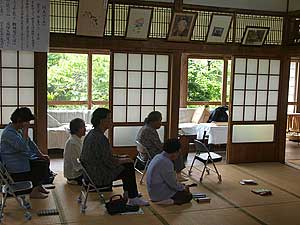
Oomoto followers wait for the monthly service to begin in Tanegashima.
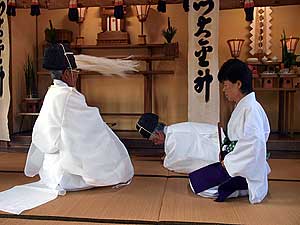
Shubatsu – ritual purification by symbolic fire. Small branches like Tanegashima often use a mixture of men and women as priests.

The branch might be small but the followers work hard at the ritual and other activities.
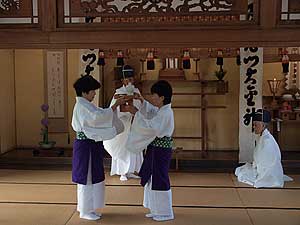
Kensen – offering.
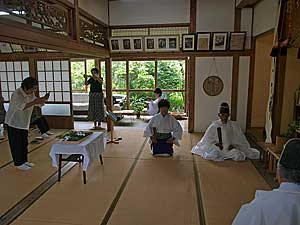
At a small branch like Tanegashima, everyone in the congregation has the opportunity to make the pine bough offering.
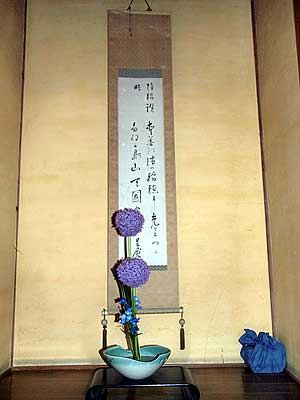
Hydrangeas usually start to blossom in late June elsewhere in Japan, but they were in full blossom on Tanegashima on May 31, when we arrived. Here is an arrangement in the shrine.
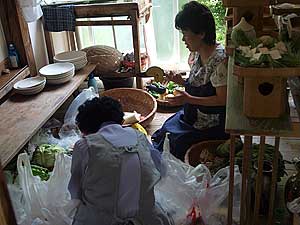
After the service, the vegetables and fruits blessed on the altar are cut up and shared among the followers. Everyone takes a bag full home.

A hydrangea in the shrine garden.
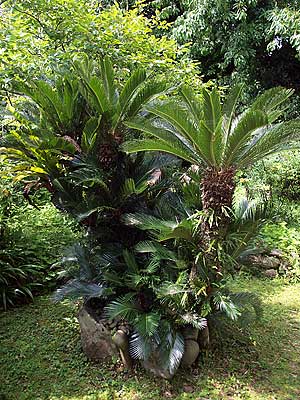
Tanegashima is known for its cycads. This one is in the shrine garden.
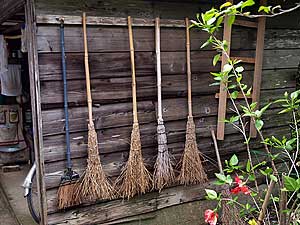
The monthly service is a day of rest for the brooms.
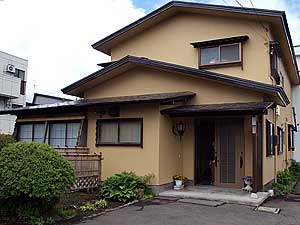
The Aomori branch meets here. The shrine is on the second floor.
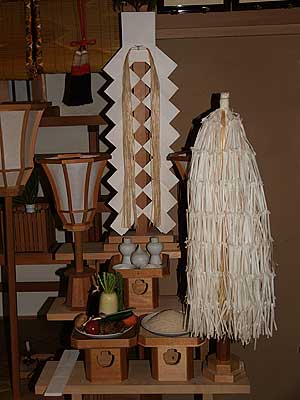
The small altar is ready for the service.
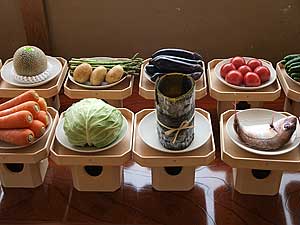
Fruits, vegetables, rice and fish wait for kensen in Aomori.
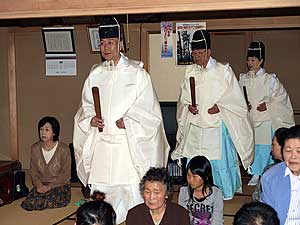
Aomori monthly service begins.
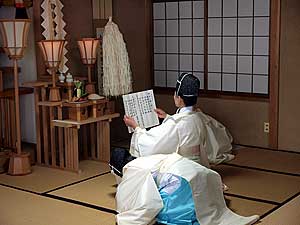
Opening prayer.

Purification.
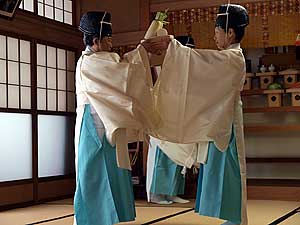
As in Tanegashima, the four priest ritual team included two women. In Aomori women wore the priest robes usually worn by men.
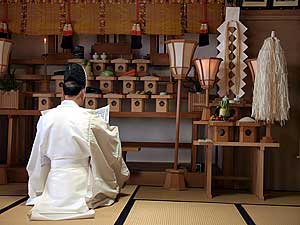
The chief priest blesses the offerings on the altar.

Pine bough offering.
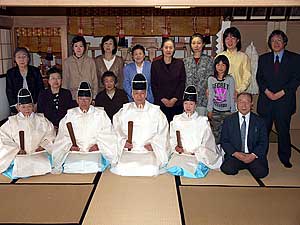
Group photo.

One member of the Aomori branch is one of Oomoto’s finest tea masters. He has several tea rooms and a beautiful tea garden in his home.
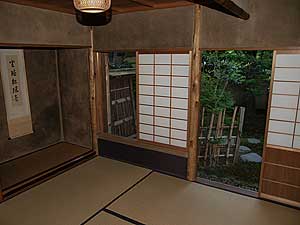
Each tea room has a view of the garden. The rooms vary in size from one that would be for a single guest to large rooms for many guests.
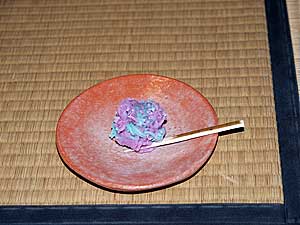
The sweet served before tea is always something made to look seasonal. Here, a hydrangea.
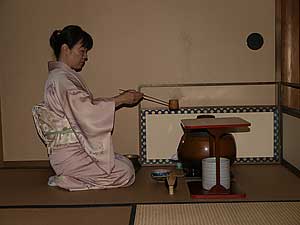
The tea master’s adult daughter makes tea for guests.

The granddaughter serves. The bowl quickly became the star of the tea ceremony!
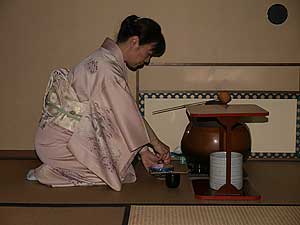
The bowl she is using is one of the 3,000 yowan (scintillating bowls) made by Onisaburo Deguchi toward the end of his life.
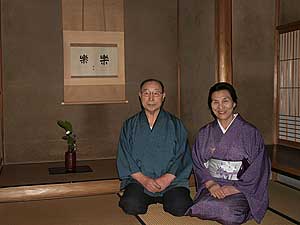
Tea master Kenichi Saito and his wife. He is a retired architect, and has practiced tea for more than 50 years.
New Contents Thu, May 20, 2010
- Oomoto participates in Sant’Egidio conference : Dialogue among religions and cultures : On divided island nation of Cyprus By Bill Roberts
- Photo Album : Portraits of three branches: Shoko, Tanegashima and Aomori By Bill Roberts
- Oomoto FAQ
- A Letter from Oomoto : Of mountains and myths By Bill Roberts
- Polyglot poem festival The Utamasturi is going international — what’s next? By Bill Roberts
- Ethics education program captures the spirit of Bankyo Dokon By Bill Roberts
- A Letter from Oomoto : A year’s worth of adventure in a summer of branch visits By Bill Roberts
- In Kumamoto, it’s all about water – and fire By Bill Roberts
- A speech by Nevada Taylor at the Kii Branch in Wakayama Prefecture on April 13, 2008.:An Encounter With Oomoto Through Aikido
- Utamatsuri, Poem Festival, in Tokyo(on April 17, 2008)
- A speech by Neil Ryan Walsh at the Kobe branch on Mar. 9th, 2008.:Planting the Seeds of the Soul
- Meeting with the Fifth Spiritual Leader of Oomoto, Madame Kurenai Deguchi by Neil Ryan Walsh
- A speech by Neil Ryan Walsh at the Nagoya branch on Feb. 17th, 2008.:The Japanese Arts beyond National Boundaries
- To the Oomoto branch in Nagoya: City of Eel and Toyota by Neil Ryan Walsh
- A Speech by Nissim Ben Shitrit, Ambassador of Israel on the occasion of the Oomoto Setsubun Grand Festival in Ayabe February 3rd, 2008 : Japan and Israel : Two Lands Balancing the Needs of Traditional Culture and Modern Life. r
- A permanent memorial to Onisaburo (A Speech at the Autumn Grand Festival , November 6, 2007 : )By James Parks Morton, Founder and Chair, Emeritus of The Interfaith Center of New York
- Israel, Palestine and the Power of Poetry(Oomoto believes small efforts can have lasting ripple effects on people and peace)By Bill Roberts
- “Something Great”(This genetics pioneer, a friend of Oomoto, offers a clue to the mystery of life)By Bill Roberts
- Kamishima Cleanup (Harima branch members regularly visit this sacred island to keep the shrine tidy)By Bill Roberts
- Kyotaro Deguchi was one of six recipients of the 2007 James Parks Morton Interfaith Award
What is Oomoto?
- What is Oomoto?
- Spirtual Centers
- Founders and Spiritual Leaders
- History
- Organization and activities
- Teachings and scriptures
- Art Works of Founders and Leaders
Opinions[Archive]
- Statement of regret for the outbreak of war against Iraq (March 20,2003)
- Jinrui Aizenkai dispatched the "Urgent Appeal for a World (Global) Crisis" on March 14.
Grappling with Bioethics[Archive]
- Oomoto’s support for abolishing the death penalty (12, June 2003)
- The Oomoto Foundation protests any birth of a human clone baby. (5, January 2003)
- OOMOTO'S VIEW REGARDING JAPAN’S PERMITION TO THE RESERCH OF HUMAN EMBRYONIC STEM CELLS (ES cells)(12, June 2000)
Vistor’s Review[Archive]
- A speech by Bill Roberts at the Oomoto branch in Hiroshima after its monthly service on March 18, 2007:Encounters with war and peace
- How Bankyo Dokon changed one life by Linda Macphee
- A speech by Bill Roberts at the Hokuriku (Kanazawa) branch on Dec. 3, 2006:Ritual and myth -an encounter with ‘divine madness’
- A speech by Bill Roberts at the Himeji Cultural Center on Feb. 25, 2007:Mesmerized by the Japanese Arts
- A speech by Bill Roberts at the Kobe branch on Feb. 11th, 2007.:There are just human tears and human joy
- A Speech on the occasion of the Oomoto Setsubun Grand Festival in Ayabe February 3rd, 2007 : Egypt's role in Middle East peace
- Keynote Speech for the 28th World Federation Japanese Religionists Conference for World Peace in Tokyo (at Kokugakuin University, Novermber 29, 2006):Vision for Peace in the Middle East By Dr. Munther S. Dajani, Professor Dean, Faculty of Arts, Al Quds University, Jerusalem
- A speech to the Kyoto branch:Spiritual adventures in researching Oomoto leaders
- A Speech at The Oomoto Foundation on Monday, November 6, 2006 : Jordan's role in Middle East By Samir Nouri, Ambassador of the Hashemite Kingdom of Jordan
- A letter from Oomoto:The Young People of Tottori
- A speech by Bill Roberts on the occasion of the dedication ceremony for the new shrine of Tottori Branch By Bill Roberts Oct. 8, 2006
- A speech by Bill Roberts at the Oomoto branch in Hiroshima after its monthly service on March 18, 2007:Encounters with war and peace
- How Bankyo Dokon changed one life by Linda Macphee
- A speech at Setsubun : A Portrait of Oomoto By Bill Roberts Feb. 3, 2006
- New Publication ! By Bill Roberts Feb. 3, 2006 A Portrait of Oomoto
you can read this book in html => http://www.jinruiaizenkai.jp/English/en-kolumno/en-bill/en-sugao/billbook1en.html
E-mail below to order brobert1@ix.netcom.com
Current Topics
- Prayer Offering and World Religious Forum II
- Living the art of dialogue
- Kyotaro Deguchi was one of six recipients of the 2007 James Parks Morton Interfaith Award
Books
Online Books
- Divine Signposts by Onisaburo DEGUCHI
- The Creation of Meaning by Hidemaru Deguchi
- Bankyo Dokon(Seventy years of Inter-Religious Activity at Oomoto)
- Nao Deguchi — A Biography of the Foundress of Oomoto
- The Great Onisaburo Deguchi published by Aiki News
- Bankyo Dokon Seventy Years of Inter-Religious Activity at Oomoto
- Insearch of Meaning
- Nao Deguchi A Biography of the Foundress of Oomoto
- A Portrait of Oomoto By Bill Roberts
Oomoto international Archive
- The History of Oomoto (Jan.– Mar. 1980 — Apr.– Jun. 1982)
- The Ancestors; Friends or Foes? (Apr.– Jun. 1987)
- Tsukinamisai; The Sabbath of Shinto (Jan.– Jun. 1983)
- The Poem Festival at Oomoto; An Ancient Rite Lives Again (Oct.– Dec. 1981)
- Purification of the Universe ; Oomoto's Setsubun Festival (Apr.– Jun. 1981)
Links
Flowers at Ten'on-kyo & Baisho-en (photographs)
Contact
All rights reserved : the Oomoto Foundation Produced by the Netinformational Commission
Since : Mar. 7.1998 Last Update : Thu, May 20, 2010
E-mail : webmaster@oomoto.or.jp
Top Page Nihongo Esperanto Português Roomazi



